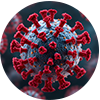
Antibiotics are a group of various substances that can be divided into several groups (approximately 16 groups) according to the origin, structure and mechanism of action. Based on this, each antibiotic works against a different spectrum of bacteria. To increase their effectiveness, antibiotics can be combined with different mechanisms of action. Overuse of antibiotics (in both human and veterinary medicine) results in the development of resistance.
Antimicrobial resistance is the ability of bacteria to resist the effects of antibiotics (reduced or lost effectiveness) and is caused mainly by their unnecessary or incorrect use.
How the spread of resistant bacteria can be prevented:
If the infection is caused by resistant bacteria, it is advisable to determine the susceptibility and use an antibiotic according to the results of the microbiological laboratory.
Freely according to the web portal of the Czech Pharmaceutical Chamber for the public Lékárnické drops, 22.11.2021

30. 11. 2025
The pitfalls of mail order dispensingAt the recent XXXIVth congress of delegates of the Czech Chamber of Pharmacists, the discussion about the possibility of introducing mail order dispensing was reopened ...

31. 10. 2025
Hepatitis A (viral hepatitis A) is an infectious inflammatory liver disease caused by the hepatitis A virus. It is transmitted by the fecal-oral route either by ...